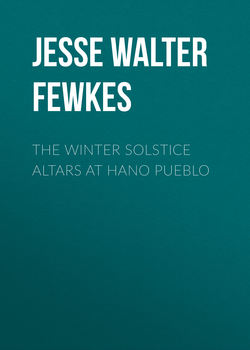The Winter Solstice Altars at Hano Pueblo

Реклама. ООО «ЛитРес», ИНН: 7719571260.
Оглавление
Jesse Walter Fewkes. The Winter Solstice Altars at Hano Pueblo
Introduction
Clan Composition of Hano
Tewa Legends
Differences in Social Customs
Contemporary Ceremonies
The Winter Solstice Ceremony
Kivas at Hano
Altar in the Moñkiva at Hano
Altar in the Tewakiva at Hano
Conclusions
Отрывок из книги
The pueblo called Hano is one of three villages on the East Mesa of Tusayan and contained, according to the writer's census of 1893, a population of 163 persons. It was settled between the years 1700 and 1710 by people from Tcewadi, a pueblo situated near Peña Blanca on the Rio Grande in New Mexico. Although only six persons of pure Tanoan ancestry are now living at Hano, the inhabitants still speak the Tewa dialect and claim as kindred the peoples of San Juan, Santa Clara, San Ildefonso, Pojoaque, Nambe, and Tesuque.5 The best traditionists declare that their ancestors were invited to leave their old home, Tcewadi, by the Snake chief of Walpi, who was then pueblo chief of that village. They claim that they made their long journey to give aid against the Ute Indians who were raiding the Hopi, and that they responded after four consecutive invitations. The Walpi Snake chief sent them an embassy bearing prayer-sticks as offerings, and although they had refused three invitations they accepted the fourth.
According to traditions the following clans have lived in Hano, but it is not stated that all went to the East Mesa together from Tcewadi: Okuwuñ, Rain-cloud; Sa, Tobacco; Kolon, Corn; Tenyük, Pine; Katcina, Katcina; Nañ, Sand; Kopeeli, Pink Shell; Koyanwi, Turquoise; Kapolo, Crane; Tuñ, Sun; Ke, Bear; Te, Cottonwood; Tayek (?); Pe, Firewood; and Tceta, Bivalve shell.
.....
Sa-towa, or Tobacco clan. – Men and boys: Anote, Asena, Tem[)e], Ipwantiwa, Howila, Nuci, Yauma, Satee (8). Women and girls: Okañ, Heli, Kotu, Kwañ, Mota (5). Total, 13.
Kolon-towa, or Corn clan. – Men and boys: Polakka, Patuñtupi, Akoñtcowu, Komaletiwa, Agaiyo, Tcid[)e], Oba, Toto, Peke, Kelo, Tasce (11). Women and girls: Kotcaka, Talikwia, Nampio, Kweñtcowû, Heele, Pelé, Kontce, Koompipi, Chaiwû, Kweckatcañwû, Awatcomwû, Antce (12). Total, 23.
.....